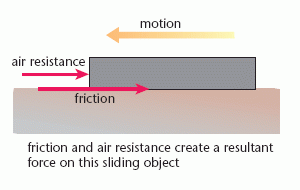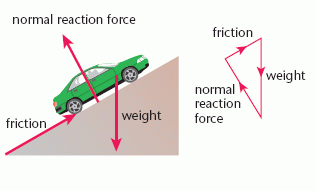The First Law
Newton’s first law states that:
An object maintains its state of rest or uniform motion unless there is a resultant force acting on it.
At first, this seems contrary to everyday experience. Give an object a push and it slows down before coming to rest. This is not ‘continuing in a state of uniform motion’. Newton realised that in this case the unseen resistive forces of friction and air resistance together act in opposition to the motion; as there is no longer a driving force after the object has been pushed, there is a resultant backwards-directed force acting on it.

The phrase ‘uniform motion’ means moving in a straight line at constant speed; i.e. moving at constant velocity.
Motion without resistive forces is difficult to achieve on Earth: there is always air resistance or friction from a surface that a moving object rests on. The nearest that we can get to modelling motion with no resistive forces is to study motion on ice or an air track.
The converse of Newton’s first law is also true:
if an object is at rest or moving at constant velocity the resultant force on it is zero
This means that where there are two forces acting on an object that satisfies these conditions, they must be equal in size and opposite in direction. If there are three or more forces acting then the vector diagram is a closed figure.
The closed figure is a triangle if there are three forces acting; a quadrilateral for four forces, etc.

You have already studied examples of a vehicle moving at constant velocity where the driving force and resistive force are equal in size and act in opposite directions. The diagram shows an example of a situation where three forces sum to zero; it illustrates a vehicle parked on a hill at rest and a vector triangle that shows the forces.
A normal reaction force acts on all four wheels; the arrow shown on the diagram represents the sum of these forces.
